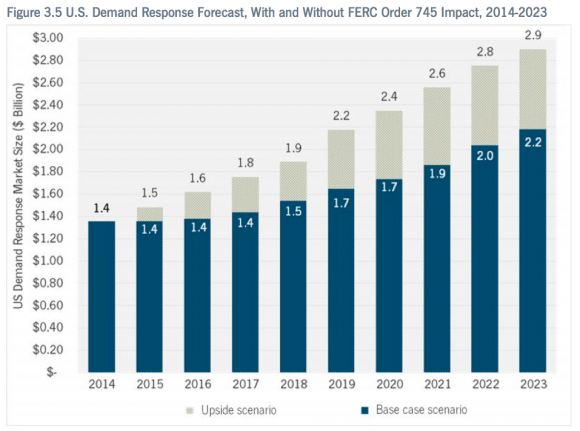The U.S. demand response market took a hit in May when an appeals court ruled against a federal order requiring grid operators to pay wholesale prices for demand reductions bid into the system in real time.
Although real-time economic demand response is a much smaller market than capacity-based demand response, the ruling will undoubtedly impact growth at a time when companies are looking at new opportunities to expand the maturing market.
According to projections from a new GTM Research report, industry revenues in the U.S. will be $4.4 billion lower over the next decade than they would have been if FERC Order 745 were kept in place. The legal battle over Order 745 could head to the Supreme Court, but it's gone for now.
Source: GTM Research report Demand Response Outlook 2014
So where are the future opportunities for growth? There are four areas where demand response providers may be able to expand their services.
"The way we think about demand response is fundamentally shifting,” said demand response report co-author Mei Shibata. “The adoption of new DR technologies and distributed energy resources is creating unprecedented opportunities -- as well as uncertainties -- around demand optimization.”
1. Combine energy efficiency with demand response
Realizing the need to shift beyond traditional demand response, EnerNOC has been working to expand its software services to include continuous energy management and utility bill management offerings. The company expects this will add $70 million in additional revenues by 2016. Competitor Comverge has also undertaken a similar strategy in the residential, commercial and industrial markets.
BuildingIQ sits on the other end of the spectrum. The company sells software for continuous commissioning of buildings, which can then be leveraged later for demand response offerings, as it is currently doing with NV Energy in Nevada.
"This enables the customer to initially invest in one platform and then layer on new energy services later," write Shibata and her co-author Geoff Wyatt.
2. Behavioral demand response
Residential demand response programs have been around for a long time, but historically they have seen very low participation rates. Opower is attempting to reinvent the market through behavioral demand response, which leverages its existing consumer engagement strategy to encourage people to reduce energy during peak times.
Opower's first customer, BGE, is enrolling all smart meter customers into a peak rebate program based on time-of-use pricing. Opower analyzes consumption patterns based on the smart meter data and then sends customized signals to customers through email, text, phone or a web portal to give them recommendations for reducing consumption. Last summer, the company says it cut energy use by 5 percent among customers with no hardware installed (i.e., direct load control switches on air conditioners) during events, while dropping the per-kilowatt cost of demand response by 40 percent.
Opower now has 1 million customers enrolled in its behavioral demand response program, and sees the offering as central to its expansion strategy.
3. Bring-your-own-thermostat programs
Utilities are becoming increasingly interested in bring-your-own-thermostat residential demand response, which reduces their expenditures on hardware. Under these programs, homeowners will buy their own smart thermostats and then enroll in a peak rebate program through the power company. Numerous thermostat and energy management providers are getting in on the action, which has spread to around half a dozen utility territories.
"BYOT programs are enabling a drastic increase in the size of the DR pie by having customers cover the cost of DR-enabled hardware," write Shibata and Wyatt.
Although these programs are still in their infancy, utilities have successfully enrolled tens of thousands of customers who are getting new value out of their thermostats or home energy management platforms.
4. Distributed energy integration
Over the long term, demand response providers are starting to eye the integration of intermittent distributed generation as a possible business opportunity. This will likely be driven by individual utilities or grid operators looking at a holistic strategy for managing high levels of solar and wind, as Hawaiian Electric Company has proposed in its recent integration plan. (EnerNOC started pursuing this strategy in 2010, when it signed a contract with the Bonneville Power Administration to manage wind with demand response.)
However, no vendors are currently offering a full-service platform to manage both demand response and on-site generation, which limits the option in the short term. Shibata and Wyatt contend that utilities or building owners would currently be better served using software for each specific offering.
"DG integration is a very smart way for DR to expand, but I think utilities shouldn't be asking for full-blown DR-DG platforms from vendors. They simply don't exist," said Wyatt.
That could change in both the residential and commercial/industrial sector as vendors seek to tie multiple services together and expand beyond simple efficiency services. But for now, "it's all theoretical," said Wyatt.
The loss of FERC Order 745 is certainly a blow to companies looking to the economic demand response market. But it's not a disastrous loss by any means. As these other markets emerge, there will be many other opportunities to expand offerings.
For more context on the demand response market, see GTM Research's new report, Demand Response Outlook 2014.




